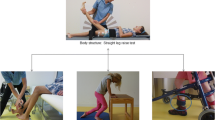Abstract
Background
Stiff-knee gait is a common gait deviation in individuals with cerebral palsy (CP) due to rectus femoris (RF) muscle spasticity. The Duncan-Ely test is a velocity-dependent measurement of spasticity that is recorded as positive or negative. At our institution, we use a modification of the Duncan-Ely test, a 5-point ordinal rating scale, which delineates where the catch occurs within the rapid arc of knee flexion. It has been named the Root-Ely test.
Questions/Purposes
We sought to determine the intra- and inter-rater reliability of the Duncan-Ely and Root-Ely tests in pediatric patients with CP.
Methods
A convenience sample of 20 ambulatory subjects was recruited; mean age was 10.5 ± 4.5 years, and the Gross Motor Function Classification System (GMFCS) levels were I–III. Five clinicians measured each individual’s RF spasticity using the Root-Ely protocol during a single visit. Simple κ statistics with 95% confidence intervals (CI) were utilized for intra-rater reliability and weighted κ statistics with 95% CI for inter-rater reliability.
Results
The Root-Ely scale intra-rater reliability was 0.77 to 0.90 and inter-rater reliability was 0.32 to 0.87. Inter-rater reliability was good to excellent among experienced clinicians and fair to moderate in new clinicians.
Conclusion
The Root-Ely 5-point scale has acceptable intra- and inter-rater reliability in pediatric individuals with CP among experienced clinicians. The Root-Ely test allows experienced clinicians to reliably quantify severity of RF spasticity and may give orthopaedic surgeons a clinical tool to better predict ideal candidates for RF transfers in individuals with CP in order to improve stiff-knee gait.

Similar content being viewed by others
References
Bleck EE. Orthopaedic management in cerebral palsy. London: Mac Keith Press; 1987.
Clopton N, Dutton J, Featherston T, Grigsby A, Mobley J, Melvin J. Interrater and intrarater reliability of the Modified Ashworth Scale in children with hypertonia. Pediatr Phys Ther. 2005;17(4):268–274.
Fosang AL, Galea MP, McCoy AT, Reddihough DS, Story I. Measures of muscle and joint performance in the lower limb of children with cerebral palsy. Dev Med Child Neurol. 2003;45(10):664–670.
Gage JR, Perry J, Hicks RR, Koop S, Werntz JR. Rectus femoris transfer to improve knee function of children with cerebral palsy. Dev Med Child Neurol. 1987;29(2):159–166.
Gracies JM, Burke K, Clegg NJ, et al. Reliability of the Tardieu scale for assessing spasticity in children with cerebral palsy. Arch Phys Med Rehabil. 2010;91(3):421–428.
Kay RM, Rethlefsen SA, Kelly JP, Wren TA. Predictive value of the Duncan-Ely test in distal rectus femoris transfer. J Pediatr Orthop. 2004;24(1):59–62.
Landis JR, Koch GG. The measurement of observer agreement for categorical data. Biometrics. 1977;33(1):159–174.
Lee SY, Sung KH, Chung CY, et al. Reliability and validity of the Duncan-Ely test for assessing rectus femoris spasticity in patients with cerebral palsy. Dev Med Child Neurol. 2015;57(10):963–968.
Marks MC, Alexander J, Sutherland DH, Chambers HG. Clinical utility of the Duncan-Ely test for rectus femoris dysfunction during the swing phase of gait. Dev Med Child Neurol. 2003;45(11):763–768.
Mutlu A, Livanelioglu A, Gunel MK. Reliability of Ashworth and modified Ashworth scales in children with spastic cerebral palsy. BMC Musculoskelet Disord. 2008;9:44.
Numanoglu A, Gunel MK. Intraobserver reliability of Modified Ashworth Scale and modified Tardieu scale in the assessment of spasticity in children with cerebral palsy. Acta Orthop Traumatol Turc. 2012;46(3):196–200.
Ounpuu S, Muik E, Davis RB, 3rd, Gage JR, DeLuca PA. Rectus femoris surgery in children with cerebral palsy: Part I: The effect of rectus femoris transfer location on knee motion. J Pediatr Orthop. 1993;13(3):325–330.
Palisano RJ, Hanna SE, Rosenbaum PL, et al. Validation of a model of gross motor function for children with cerebral palsy. Phys Ther. 2000;80(10):974–985.
Perry J, Burnfield JM, Cabico LM. Gait analysis: normal and pathological function. Thorofare, NJ: SLACK; 2010.
Sim J, Wright CC. The kappa statistic in reliability studies: use, interpretation, and sample size requirements. Phys Ther. 2005;85:257–268
Yam WK, Leung MS. Interrater reliability of Modified Ashworth Scale and modified Tardieu scale in children with spastic cerebral palsy. J Child Neurol. 2006;21(12):1031–1035.
Acknowledgements
The authors acknowledge Leon Root, MD (1929–2015), for providing exceptional care to his patients and for generously sharing his time and knowledge with his colleagues. He was and continues to be an inspiration to all. Thank you to all patients and families who volunteered to participate in this study.
Author information
Authors and Affiliations
Corresponding author
Ethics declarations
Conflict of Interest
Lisa C. Drefus, PT, DPT, Siobhan Clarke, PT, DPT, Karen Resnik, PT, DPT, Jayme Koltsov, PhD, Emily R. Dodwell, MD, David M. Scher, MD declare that they have no conflicts of interest.
Human/Animal Rights
All procedures followed were in accordance with the ethical standards of the responsible committee on human experimentation (institutional and national) and with the Helsinki Declaration of 1975, as revised in 2013.
Informed Consent
Informed consent was obtained from all patients for being included in this study.
Required Author Forms:
Disclosure forms provided by the authors are available with the online version of this article.
Additional information
Level of Evidence: Diagnostic Study, Level III
Work performed at Hospital for Special Surgery
Electronic supplementary material
ESM 1
(PDF 1224 kb)
Rights and permissions
About this article
Cite this article
Drefus, L.C., Clarke, S., Resnik, K. et al. The Root-Ely Modified Test of Rectus Femoris Spasticity Has Reliability in Individuals with Cerebral Palsy. HSS Jrnl 14, 143–147 (2018). https://doi.org/10.1007/s11420-018-9609-5
Received:
Accepted:
Published:
Issue Date:
DOI: https://doi.org/10.1007/s11420-018-9609-5




